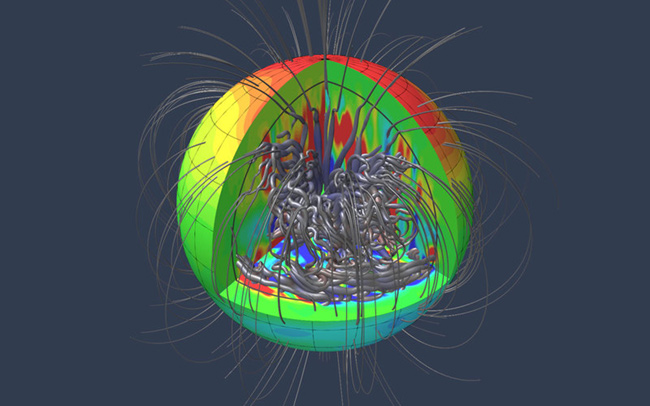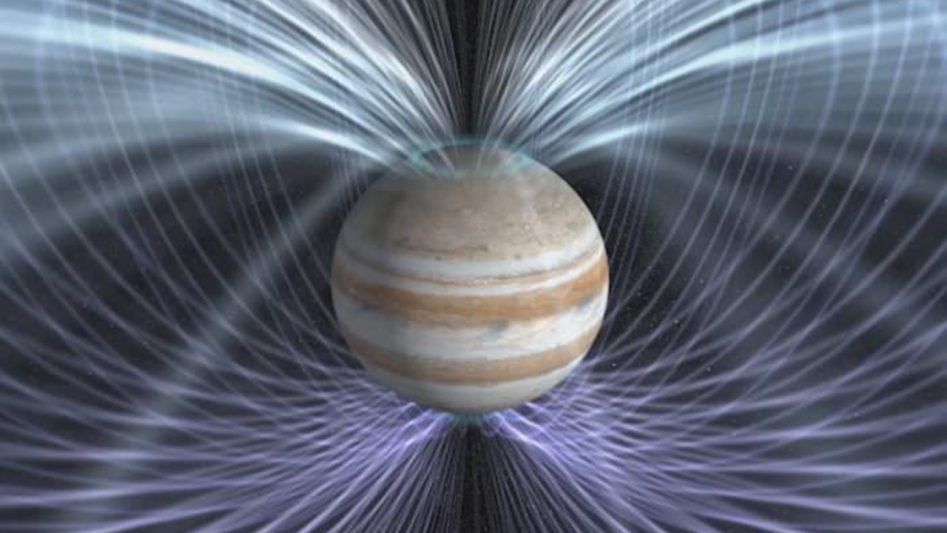What is the largest single structure in our solar system? The answer that immediately comes to mind for most of us is the Sun. But that is actually incorrect. The largest single structure in our solar system is Jupiter’s magnetosphere.
Think of a magnetosphere as a gigantic shield. It is the boundary where Jupiter’s magnetic field meets the solar wind and diverts it, sort of like Jupiter’s very own windbreak. The stronger the magnetic field around a planet, the larger the magnetosphere. Jupiter’s is so big, that it could swallow up the Sun 15 times!
But what about the heliosphere? Technically, the heliosphere is like a gigantic soap bubble that makes up the outer edge of the solar system (although it’s not necessarily a perfect sphere, but you get the idea). It is the furthest reach of the solar wind before interstellar space takes over and the largest object floating around inside of that bubble is Jupiter’s magnetosphere.
Magnetic fields are generated within a planet by the movement of a liquid inner core. I use the term “liquid” loosely here. It is really a mixture of metals acting like a liquid. Earth’s magnetic field, for example, is generated because our planet has a liquid metal core made from iron and nickel. As the core moves around, electrical charges are generated and voila! Magnetic field. Mars, by contrast, has very little magnetic field because it’s core is presumably solidified (nobody knows why, but the Mars InSight Lander is on its way there to find out). The magnetic field protects the planet from the charged solar particles unleashed on a regular basis by our pal, the Sun.
Jupiter, largest of all the planets, of course, possesses the most massive magnetic field, beating the Earth’s in strength by 20,000x. For years, Jupiter’s gigantic reach has been known, but very little about it is understood. That, however, is changing with the Juno mission, currently in a polar orbit around Jupiter. One of Juno’s primary purposes is to map the magnetic field and help us to better understand our biggest neighbor. And understanding Jupiter, means a better understanding of how our solar system was built and how it operates.
So wait, Jupiter is made primarily of hydrogen and oxygen, right? And it’s a gas giant, right? How can it have a magnetic field if the whole thing is made out of gas? The answer to that question lies in a little-known properties of a theoretical substance called liquid metallic hydrogen.
Hydrogen, the smallest and most unassuming element on the periodic table, is the primary building block of our universe, and it stands to reason that Jupiter, as it was likely the first planet to form, would be made mostly of hydrogen, just like the Sun. But hydrogen, like all other elements, tends to react differently when exposed to the forces of physics. Specifically, high-pressure physics.

The magnetic field lines illustrate the high complexity of the magnetic field inside Jupiter
Deep underneath the maelstrom of Jupiter’s surface clouds, the pressure is literally crushing and the heat is astronomical. Hotter than even the surface of the Sun. And the result of that strange, hot, pressurized environment is that hydrogen starts to act like a liquid metal. Sort of like a metallic toothpaste that moves around rapidly and creates the magnetic field.
We, as mere humans, can only theorize about the presence of liquid metallic hydrogen because the forces here on our little planet are nowhere near high enough to create it. But that doesn’t mean that it hasn’t been tried. In fact, creating liquid metallic hydrogen has been the dream of many a high-pressure physicist over the years.
In January 2017, Isaac Silvera and Ranga Dias, two Harvard scientists, used something called a diamond anvil (I can’t help but imagine Wile E Coyote running from a cartoon anvil covered in diamonds) and successfully squeezed hydrogen into a metallic state. However, there was speculation about the results, with many scientists wondering if perhaps elements in the experiment itself had interfered with the sample, creating a false positive. The sample met an anticlimactic end when the diamond anvil failed to keep pressure and the sample simply disappeared. I bet Silvera and Dias were shaking their heads over that one.
The creation of liquid metallic hydrogen could be huge though, and continues to be the holy grail of those physicists who specialize in pressure physics. If the substance is metastable, meaning it could survive at more normal pressure once created, it would serve as the world’s greatest electrical conductor and would have significant value as rocket fuel due to its incredible amount of stored energy.
Will scientists be able to recreate the sample that Silvera and Dias made? The verdict is still out on that, but this stuff is capable of creating a magnetosphere as large as Jupiter’s, the largest single structure in our solar system. And something that powerful is worth it in order to advance our understanding of Jupiter, our solar system, and the universe.
https://www.jpl.nasa.gov/news/news.php?feature=6549
https://www.universetoday.com/129669/jupiters-magnetosphere-will-blow-mind-kills-spacecraft/
https://www.space.com/39370-what-is-bizarre-metallic-hydrogen.html
https://harvardmagazine.com/2017/01/metallic-hydrogen
https://www.extremetech.com/extreme/244922-sample-metallic-hydrogen-earth-vanished


Comments
I find space fascinating – Most notably black holes, quasars and supernovas. The overwhelmingly vast scale of it all is incomprehensible. However, it’s always great to read about theories and predictions closer to home… If by close, we mean nearly 500 million miles away!
I’m always keen to hear what the latest research and theories believe is under the cloud-coverage of our distant cousins, and the thought of liquidized hydrogen “toothpaste” was definitely unexpected.
A great read, thank you!
-Richard